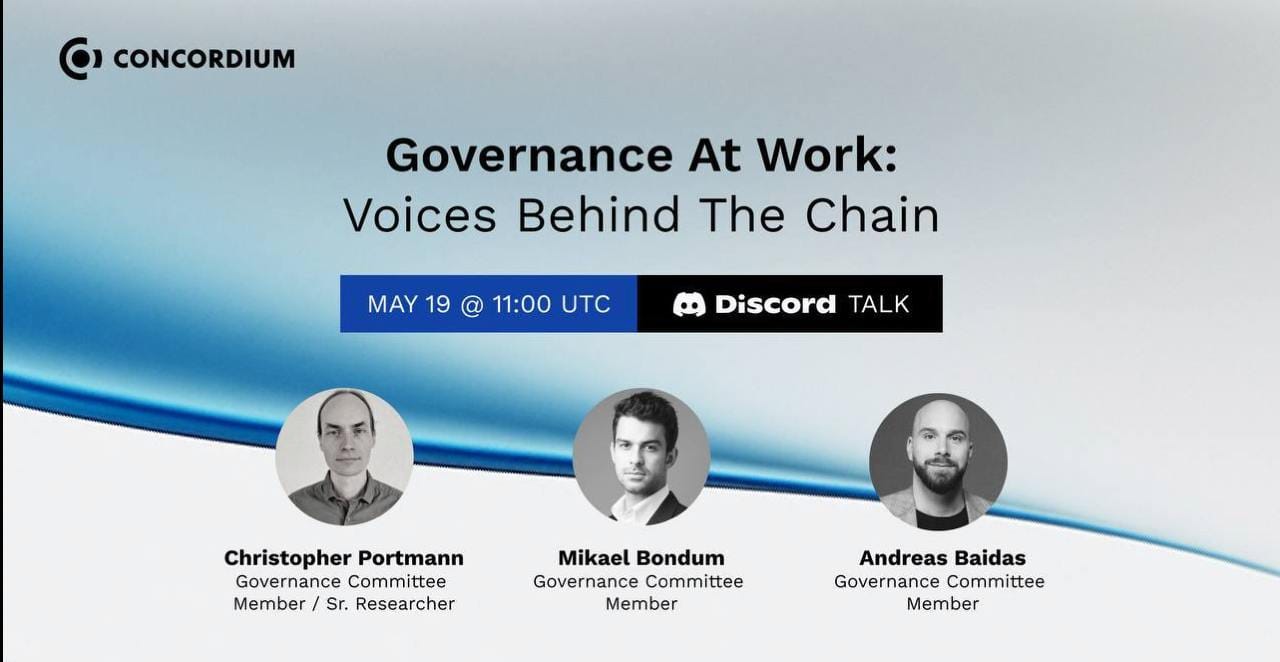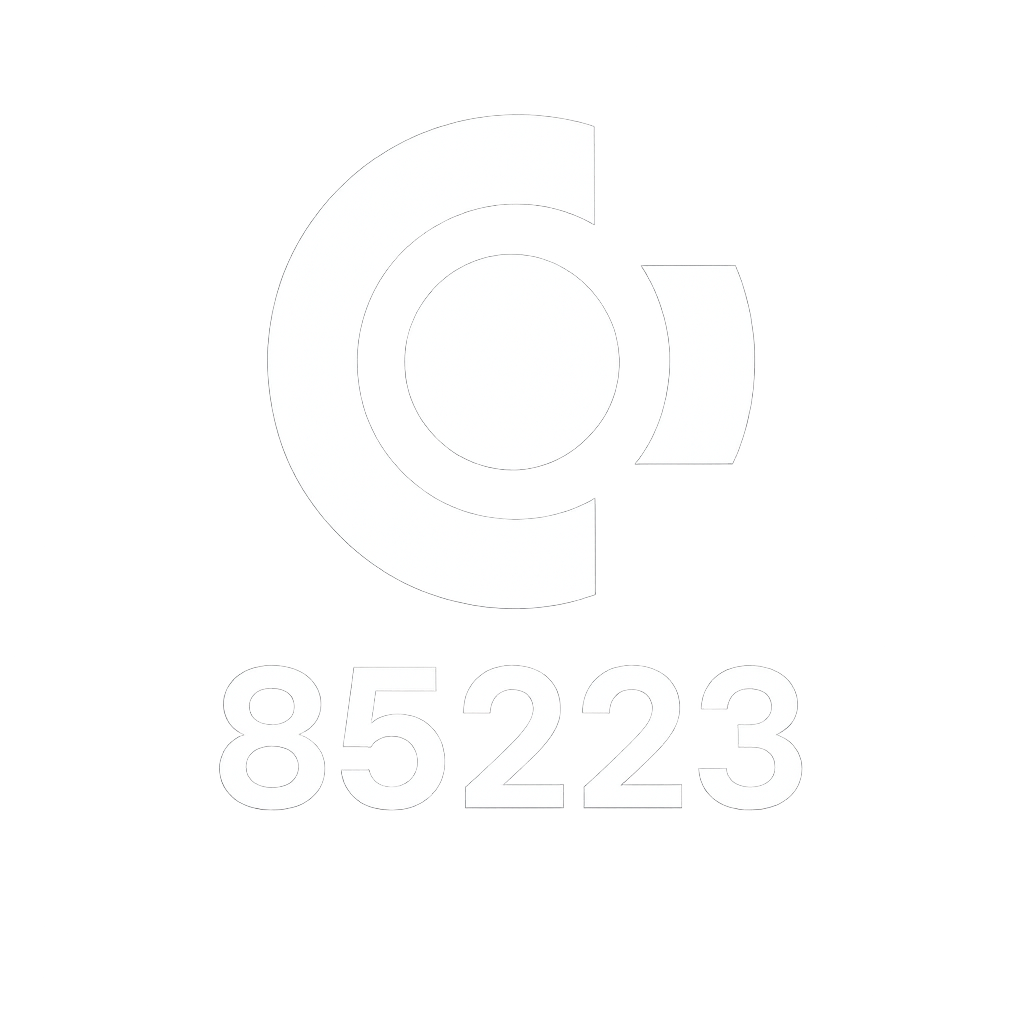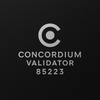Governance At Work - Voices Behind the Chain

Come along behind the chain and see how Concordium’s Governance Committee is evolving, expanding, and empowering the community, one decision at a time.
In this candid conversation, Christopher Portmann, Mikael Bondum, and Andreas Baidas unpack the inner workings of Concordium’s Governance Committee—from tokenomics and validator incentives to decentralization, trust, and the upcoming elections. Whether you’re a builder, holder, or observer, this summary offers a front-row seat to where governance is headed—and why it matters more than ever.
1 Opening Remarks & Setting the Stage
1
0:00
/245.395011
- Christopher Portmann kicks off the session, with Mikael Bondum present and Andreas Baidas participating via chat due to technical issues.
- Context
- The session is part of the ongoing governance election period for the Concordium Governance Committee (GC).
- New Nominees
- “Hills” joins existing candidates Neil (ACK), Bitcoin Portugal, and Borja (AEDX).
- Intent
- Share insights into the committee’s role, inner workings, and decentralization goals.
2 Mikael Bondum: Why I Joined the Governance Committee
2 Mikael Bondum Why I Joined the Governance Committee
0:00
/143.325011
- Mikael reflects on his journey to Concordium’s Governance Committee and the value he brings.
- Previous Involvement
- Worked with Concordium in various capacities over the past few years.
- Mission Alignment
- Deeply believes in Concordium’s ambition to solve tangible, real-world problems using blockchain technology.
- Web3 Experience
- Brings extensive experience in tokenomics and decentralization from prior roles in the Web3 industry.
- Skillset Fit
- Saw the Governance Committee’s original mandate—especially around tokenomics—as a natural match for his expertise.
- Motivation
- Wanted to remain close to the project and actively shape its direction through consistent input.
- Election & Impact
- Successfully elected last year and has since contributed to key decisions and roadmap discussions.
- Vision
- Sees potential for the Governance Committee to evolve beyond its original scope.
3 What the Governance Committee Actually Does
3 What the Governance Committee Actually Does
0:00
/90.96
- Christopher Portmann outlines the Governance Committee’s core responsibilities and how it interacts with the broader Concordium ecosystem.
- Prior Collaboration
- Christopher previously worked with Mikael in his capacity as a consultant, particularly on tokenomics and later on decentralization and technical proposal review.
- Reference Materials
- A comprehensive PDF document (linked in the blog) outlines the Governance Committee’s role, expectations, and its interaction with the Executive Management Group (EMG).
- Three Core Domains of Responsibility
- 1. Tokenomics
- Analysis and recommendations on supply, incentives, and economic parameters of the network.
- 1. Tokenomics
- 2. Decentralization of Governance
- Expanding community involvement beyond elections.
- Developing structures and tools to progressively decentralize decision-making.
- 3. Protocol Updates
- Review and provide feedback on technical proposals and protocol changes.
- Collaborate with Concordium and EMG to shape the blockchain’s evolution.
4 The Role of the Governance Committee in the Shift to Decentralization
4 The Role of the Governance Committee in the Shift to Decentralization
0:00
/114.63
- Mikael Bondum and Christopher Portmann reflect on the evolving function of the Governance Committee and its broader significance.
- Natural Progression
- Mikael sees governance structures—whether in the form of a committee or on-chain voting—as essential to any blockchain aspiring to be truly decentralized.
- Beyond Day-to-Day Work
- While the committee is active in areas like tokenomics and protocol updates, Mikael emphasizes its role in identifying new domains to decentralize over time.
- Structural Independence
- The Governance Committee is central to Concordium’s ecosystem but operates independently from the Foundation, making it a unique mechanism for bridging centralized origins with decentralized ambitions.
- Long-Term Focus
- One of the committee’s key mandates is to continuously support and accelerate the transition toward deeper decentralization.
- Redefining Itself Over Time
- Christopher highlights how the committee is evolving.
- The initial composition was entirely foundation-appointed; new community-elected members are now shaping its direction.
- These changes are gradually redefining the committee’s scope, culture, and influence.
5 Most Impactful Decision: Mint Rate Change for Validators
5 Most Impactful Decision Mint Rate Change for Validators
0:00
/64.095011
- Mikael identifies the validator-related supply adjustment as the Governance Committee’s most consequential decision in the past year.
- Validator Supply Mechanism
- The blockchain’s mint rate—governing how new tokens are created based on validator roles—was modified following the Governance Committee’s recommendation.
- Governance Impact
- This decision underscores the committee’s real influence over Concordium’s economic model and network incentives.
- Clarification
- Mikael notes this was a change to the mint rate, not the overall inflation rate, which involves other contributing factors.
6 Challenges in Serving on the Governance Committee
6 Challenges in Serving on the Governance Committee
0:00
/159.795011
- Mikael and Christopher discuss the practical and structural hurdles of guiding decentralization from within a new and evolving body.
- New and Evolving Role
- As one of the first external, community-elected members, Mikael notes that the committee is still finding its rhythm and structure.
- Difficulty Aligning with the Foundation
- It can be hard to maintain alignment between the Governance Committee’s work and the broader initiatives driven by the Concordium Foundation.
- Contextual Blind Spots
- Despite previously working inside the organization, Mikael finds it challenging at times to fully contextualize decisions and strategies now as an external member.
- Committee Adaptation
- The Governance Committee is in a continuous process of reshaping and improving how it operates and integrates with Concordium’s evolving needs.
- Resource Constraints and Prioritization
- Christopher adds that limited engineering resources present a recurring challenge.
- For example, implementing on-chain voting or broader community participation mechanisms competes for attention with protocol roadmap items like PLT token development.
- Striking the right balance in resource allocation between core development and governance decentralization requires ongoing coordination with EMG and the Foundation.
7 Key Achievements Over the Past Year
7 Key Achievements Over the Past Year
0:00
/131.775011
- Mikael and Christopher highlight significant milestones that reflect the Governance Committee’s growing influence and progress toward decentralization.
- Mint Rate Adjustment
- Confirmed as the most impactful decision—modifying the validator mint rate based on committee recommendations.
- On-Chain Elections
- Mikael emphasizes the successful execution of on-chain elections as a major standalone achievement.
- Moving from centralized appointments to community voting marks a critical step in decentralizing governance.
- Structural Independence
- Formalizing roles for individuals outside the Concordium Foundation within a governance body was seen as a significant institutional advance.
- Community-Led Policy Change
- Christopher points to the reduction of the cooldown period from 21 to 7 days as a meaningful, user-driven policy shift.
- The idea originated from Andreas and was implemented after discussion—showing how the committee can rapidly respond to valid community concerns.
- Testnet Preparations for June Elections
- Test elections using dummy candidates have been conducted.
- Decryption process is underway, and all systems are expected to be ready for the real vote in June.
8 Why Decentralized Governance Matters
8WhyDecentralizedGovernanceMatters
0:00
/280.891995
- Mikael and Christopher discuss the philosophical and practical importance of decentralizing governance, both for Concordium and the broader Web3 ecosystem.
- Core to Web3’s Purpose
- Mikael argues that decentralized governance is not a side benefit of blockchain, it is a foundational use case. While decentralized finance came first, decentralized decision-making may be the more transformative long-term application.
- Trustless by Design
- The trustless architecture of blockchain makes it possible to remove dependency on centralized actors, aligning decision-making with community interests.
- Governance as a Use Case
- Mikael suggests that governance—not finance—should perhaps have been blockchain’s first real-world use case, given its potential to address inefficiencies and mistrust in traditional political and corporate systems.
- Broader Societal Impact
- Blockchain-based governance could help tackle systemic issues in areas like voting, public accountability, and institutional trust—domains that currently suffer from opaque processes and limited public influence.
- The Governance Committee itself represents Concordium’s internal application of decentralized principles, serving as a model for what blockchain-enabled governance can look like.
- Christopher on Decentralization vs Traditional Governance
- Compares Concordium’s model to shareholder governance in Web2 corporations, which often provides only symbolic or superficial participation.
- Notes that blockchain governance, by contrast, holds the potential to create real influence for community members.
- Decentralization and Trust
- Christopher ties the governance discussion to Concordium’s current roadmap, especially its push into Web2 financial services.
- Argues that trust is the missing bridge between the promise of Web3 and its slow adoption, and that transparent, decentralized governance is a key element in building that trust.
- Visit for exclusive comments: https://t.me/c/1659427635/29745
9 What Kind of Candidates Does the Governance Committee Need?
9 What Kind of Candidates Does the Governance Committee Need
0:00
/210.39
- Mikael and Christopher outline the ideal profiles for future Governance Committee members, emphasizing diversity, outreach, and builder representation.
- Key Qualities and Backgrounds
- Beyond Technical Expertise: Mikael notes Concordium already has strong technical depth across the Foundation, Governance Committee, and community.
- People with reach, those who can bridge Concordium to new audiences and segments.
- Mikael hopes for candidates who may not traditionally be called “influencers,” but who have built a personal brand and external audience.
- These individuals could expose Concordium’s tech and values to communities not yet familiar with the project.
- As the media landscape evolves rapidly, Concordium could benefit from members who understand modern communication channels and audience engagement.
- Christopher on Balance and Diversity
- Nine-Member Committee Going Forward
- Committee size will remain fixed at nine seats, gradually replacing Foundation-appointed members with community-elected ones.
- A well-functioning committee needs a mix of backgrounds: tech, finance, community building, Web2 familiarity, and Web3 innovation.
- Too much concentration in one area (e.g., all finance or all tech) would weaken the committee’s effectiveness.
- Currently, no committee members are running projects on Concordium.
- Christopher is excited to see candidates this year who are actually building on-chain—bringing first-hand, real-world user perspective directly into governance
- Visit for exclusive comments: https://t.me/c/1659427635/29745
10 Misconceptions About Joining the Governance Committee
10 Misconceptions About Joining the Governance Committee
0:00
/103.365011
- Mikael reflects on his transition from an outsider to an elected member, and how the experience aligned with expectations.
- No Major Surprises
- Having previously collaborated with Concordium and followed the Governance Committee closely, Mikael was already well-informed about its role and operations.
- His transition into the committee felt natural, and he was pleased to find that the reality matched his expectations.
- Room for Growth
- While the committee’s current structure is functional, Mikael believes there is untapped potential for it to do more.
- Continued decentralization will require alignment and effort from all fronts: the Foundation, the community, and the committee itself.
- A Living Case Study
- Mikael suggests the committee itself can serve as a learning ground for Concordium, providing a blueprint for decentralizing other parts of the ecosystem by testing what works.
11 Compliance and Concordium’s Identity Layer
11 Andreas Baidas shares a perspective from the financial world reinforcing Concordiums regulatory positioning
0:00
/46.29
- Andreas Baidas shares a perspective from the financial world, reinforcing Concordium’s regulatory positioning.
- Regulatory Strength
- Compliance is the cornerstone of any well-functioning financial system, vital for accountability, risk mitigation, and public trust.
- Concordium’s Differentiator
- By embedding an identity layer at the protocol level, Concordium allows for verified, auditable transactions, without exposing sensitive personal data on-chain.
- This makes the chain uniquely suited for industries where regulatory clarity is non-negotiable.
- Finance as a Natural Fit
- Given its architecture, Concordium is especially well-positioned to serve the financial sector where both transparency and privacy must coexist.
12 Q&A 1 Do Projects Care About Governance?
12 QA 1 Do Projects Care About Governance
0:00
/209.34
- Mikael and Christopher respond to @OxfordOxford's community question on whether decentralized governance matters to projects—or if it’s just a “crypto native” concern.
- Mikael’s View
- Currently More Relevant to Crypto Natives
- Many teams still prioritize ease of deployment over governance quality.
- Simpler, more centralized blockchains often win in the short term because decision-making is quicker and less bureaucratic.
- But Long-Term Tradeoffs Exist
- Projects may choose the wrong blockchain due to short-term thinking or lack of awareness about long-term consequences.
- Decentralized governance is slower—but it provides robustness, predictability, and resistance to arbitrary change.
- Critical Questions for Projects to Ask
- Why are we building a decentralized application?
- What governance risks does our project face?
- Are we prepared for regulatory scrutiny, and how does the blockchain’s governance structure impact that?
- Concordium’s Advantage
- Offers a more durable governance framework, especially for projects that care about regulatory resilience and accountability.
- The presence of a partly elected committee gives greater legitimacy to decisions and lowers the risk of unexpected protocol shifts.
- Christopher’s Addition:
- More Involvement, More Influence:
- Projects building on Concordium have an opportunity to actively shape the chain’s future by engaging in governance.
- With at least two candidates this year being builders on Concordium, it’s a sign that this connection is growing stronger.
13 Q&A 2 Are Institutions Afraid of Decentralized Governance?
13 QA 2 Are institutions afraid of decentralized governance
0:00
/209.34
- Mikael follows up with another community question which raises the issue of whether large institutions might hesitate to engage with Concordium because governance lies outside their control.
- General Institutional Apprehension
- Christopher notes that large institutions are broadly wary of Web3, not necessarily because of decentralized governance, but due to security risks, regulatory uncertainty, and lack of control.
- Hacks, compliance gaps, and unpredictable behavior in decentralized systems are more immediate concerns in most institutional assessments.
- Unclear Governance Perception
- While decentralization could, in theory, make institutions nervous, it’s not yet clear how much weight they assign to governance structures specifically.
- Christopher admits it’s an open and interesting question: how do institutions perceive the presence of community-elected governance structures like Concordium’s?
- Bridging the Gap
- Part of Concordium’s ongoing challenge (and opportunity) is to make Web3 more approachable to institutional players without compromising its core principles of decentralization and trustlessness.
14 Q&A 3 Concordium Governance vs. DAO Frameworks
14 QA 3 Concordium Governance vs DAO Frameworks
0:00
/71.125011
- A community question prompts a reflection on how Concordium’s governance model compares to typical DAO structures.
- Governance Committee as a DAO Variant
- Mikael sees Concordium’s governance framework not as separate from DAOs, but as a specific implementation of the broader DAO concept.
- He emphasizes that “DAO” is an umbrella term—it doesn’t refer to a single fixed structure but a spectrum of decentralized governance mechanisms.
- Not Mutually Exclusive
- Concordium’s committee-based model fits within the DAO paradigm while offering more structure and accountability than many loosely governed token-voting DAOs.
- The framework allows for gradual decentralization while maintaining a coherent, trusted process—especially important in regulatory contexts.
15 Q&A 4 Time Commitment for Governance Committee Members
15 QA 4 Time Commitment for Governance Committee Members
0:00
/69.47
- Christopher and Mikael provide a realistic estimate of the time expected from committee members.
- Meeting Frequency
- Regular meetings take place approximately once per month.
- There is a standing schedule every two months, supplemented by ad hoc meetings as needed.
- Additional Responsibilities
- Members are expected to read emails, prepare for meetings, and engage in discussions.
- Active participation on social media—communicating about governance activities and Concordium developments—is also encouraged.
- Overall Estimate
- The role requires a few days per month on average.
- This estimate applies particularly to external members and is considered manageable alongside other professional obligations.
16 Closing Remarks and Call to Action
16 Closing Remarks and Call to Action
0:00
/145.95
- Christopher and Mikael conclude the session with encouragement for community participation and a push toward greater legitimacy through voter turnout.
- Open Call for Nominations
- All community members are encouraged to consider running for the Governance Committee.
- Broader participation will lead to a more diverse and representative body.
- Importance of Voting
- Voting in the June elections is just as critical as nominating candidates.
- Greater voter turnout increases the legitimacy and influence of the committee.
- Last year, approximately 5% of all CCD voted, but accounting for non-voting entities (like exchanges and the Foundation), the effective rate was closer to 10%.
- This year’s goal: double the participation.
- Final Encouragements
- Being a candidate is a valuable experience, both for individual contributors and for Concordium’s future.
- Community discussion continues in the “Governance” thread on Concordium’s Future Channel.
- Closing Words from Mikael
- Expresses gratitude for the invitation and dialogue.
- Looks forward to future engagements and continuous improvement of the governance process.

